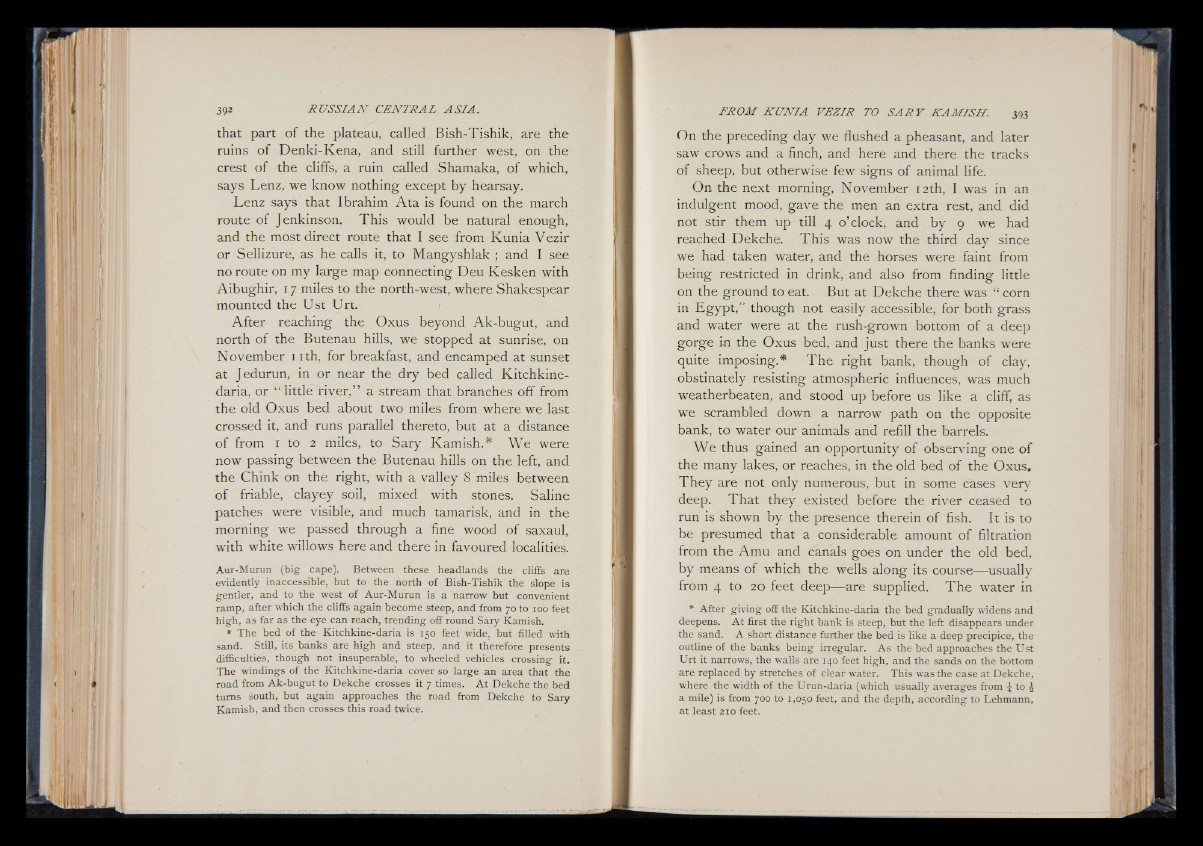
that part of the plateau, called Bish-Tishik, are the
ruins of Denki-Kena, and still further west, on the
crest o f the cliffs, a ruin called Shamaka, of which,
says Lenz, we know nothing except by hearsay.
Lenz says that Ibrahim Ata is found on the march
route of Jenkinson. This would be natural enough,
and the most direct route that I see from Kunia Vezir
or Sellizure, as he calls it, to Mangyshlak ; and I see
no route on my large map connecting Deu Kesken with
Aibughir, 1 7 miles to the north-west, where Shakespear
mounted the Ust Urt. t
After reaching the Oxus beyond Ak-bugut, and
north of the Butenau hills, we stopped at sunrise, on
N ovember 11 th, for breakfast, and encamped at sunset
at Jedurun, in or near the dry bed called Kitchkine-
daria, or “ little river,” a stream that branches off from
the old Oxus bed about two miles from where we last
crossed it, and runs parallel thereto, but at a distance
of from 1 to 2 miles, to Sary Kamish.* We were
now passing between the Butenau hills on the left, and
the Chink on the right, with a valley 8 miles between
of friable, clayey soil, mixed with stones. Saline
patches were visible, and much tamarisk, and in the
morning we passed through a fine wood of saxaul,
with white willows here and there in favoured localities.
Aur-Murun (big cape). Between these headlands the cliffs are
evidently inaccessible, but to the north of Bish-Tishik the slope is
gentler, and to the west of Aur-Murun is a narrow but convenient
ramp, after which the cliffs again become steep, and from 70 to 100 feet
high, as far as the eye can reach, trending off round Sary Kamish.
* The bed of the Kitchkine-daria is 150 feet wide, but filled with
sand. Still, its banks are high and steep, and it therefore presents
difficulties, though not insuperable, to wheeled vehicles crossing it.
The windings of the Kitchkine-daria cover so large an area that the
road from Ak-bugut to Dekche crosses it 7 times. At Dekche the bed
turns south, but again approaches the road from Dekche to Sary
Kamish, and then crosses this road twice.
On the preceding day we flushed a pheasant, and later
saw crows and a finch, and here and there the tracks
of sheep, but otherwise few signs of animal life.
On the next morning, November 12th, I was in an
indulgent mood, gave the men an extra rest, and did
not stir them up till 4 o’ clock, and by 9 we had
reached Dekche. This was now the third day since
we had taken water, and the horses were faint from
being restricted in drink, and also from finding little
on the ground to eat. But at Dekche there was “ corn
in Egypt,” though not easily accessible, for both grass
and water were at the rush-grown bottom of a deep
gorge in the Oxus bed, and just there the banks were
quite imposing.* T he right bank, though of clay,
obstinately resisting atmospheric influences, was much
weatherbeaten, and stood up before us like a cliff, as
we scrambled down a narrow path on the opposite
bank, to water our animals and refill the barrels.
We thus gained an opportunity of observing one of
the many lakes, or reaches, in the old bed o f the Oxus.
T h e y are not only numerous, but in some cases very
deep. That they existed before the river ceased to
run is shown by the presence therein of fish. It is to
be presumed that a considerable amount o f filtration
from the Amu and canals goes on under the old bed,
by means of which the wells along its course— usually
from 4 to 20 feet deep— are supplied. T h e water in
* After giving off the Kitchkine-daria the bed gradually widens and
deepens. At first the right bank is steep, but the left disappears under
the sand. A short distance further the bed is like a deep precipice, the
outline of the banks being irregular. As the bed approaches the Ust
Urt it narrows, the walls are 140 feet high, and the sands on the bottom
are replaced by stretches of clear water. This was the case at Dekche,
where the width of the Urun-daria (which usually averages from J to ^
a mile) is from 700 to 1,050 feet, and the depth, according to Lehmann,
at least 210 feet.